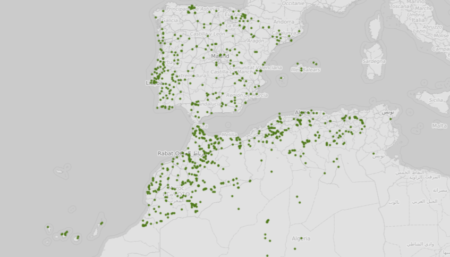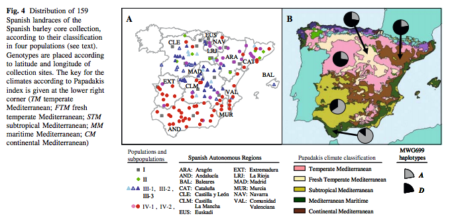- AdaptMap: exploring goat diversity and adaptation. Strong geographic structuring.
- Insights into the genetic diversity of indigenous goats and their conservation priorities. “…if one breed could survive in changing conditions all the time, the straightforward approach is to increase its utilization and attraction for production via mining breed germplasm characteristic.” If…
- Leveraging agriculture for nutrition in South Asia: What do we know, and what have we learned? To do its part for nutrition, agriculture needs to play nice with other sectors. Here comes the evidence base.
- A global synthesis reveals biodiversity-mediated benefits for crop production. Service-providing organisms really do provide services.
- Intensifying Inequality? Gendered Trends in Commercializing and Diversifying Smallholder Farming Systems in East Africa. Commercialization good for men, diversification good for women. Maybe do both? And more on commercialization.
- Iron biofortification interventions to improve iron status and functional outcomes. Cognitive performance improved, but no effect on iron deficiency or anaemia. So complicated.
- In vitro tissue culture of apple and other Malus species: recent advances and applications. Lots of tinkering still needed.
- Mediterranean and Northern Iberian gene pools of wild Castanea sativa Mill. are two differentiated ecotypes originated under natural divergent selection. One xeric, the other mesophytic. Satisfyingly uncomplicated.
- Guidelines for seed collection of Araucaria angustifolia (Bertol.) Kuntze: A genetic, demographic and geographic approach. Watch out for fragmentation.
- Screening of wild potato genetic resources for combined resistance to late blight on tubers and pale potato cyst nematodes. 5% of about 1000 very resistant. Another 1000 to go.
- Connecting genebanks to farmers in East Africa through the distribution of vegetable seed kits. Distributing 42,000 seed kits with 183,000 vegetable seed samples in 5 years generates lots of questions.
- Role and management of soil biodiversity for food security and nutrition; where do we stand? We stand uncertain is where we stand.
- Genetic Approaches to Improve Common Bean Nutritional Quality: Current Knowledge and Future Perspectives. Not as nutritious as it could be.
- Trophic Cascade in Seaweed Beds in Sanriku Coast Hit by the Huge Tsunami on 11 March 2011: Sea Urchin Fishery as a Satoumi Activity Serving for Increase in Marine Productivity and Biodiversity. Human-intervention-encourages-biodiversity shock. In other news, Japan has a sea urchin fishery.
- Molecular evidence for repeated recruitment of wild Christmas poinsettia (Euphorbia pulcherrima) into traditional horticulture in Mexico. Fancy genotyping shows plants in gardens were transplanted from the wild. Why not just ask the gardeners though?
The wheat in Spain grows all over
The researchers were also able to group Spaniards into five genetic clusters. On a map, these groups form five strips running north to south. Those strips line up neatly with history.
I wonder if you’d get a similar pattern looking at crops, say wheat. There’s lots of material in genebanks to play around with.
LATER: Thanks to David Marshall for pointing out that work has been done on barley.
It just needs someone to compare the patterns now. And repeat for other crops.
Brainfood: Forage seeds, Meat is murder, Medieval farming, Bean breeding, Moth bean genomics, Red List definitions, Amaranth domestication, Seed networks, Local adaptation, Social norms, Food demand, Grasspea future, Strawberry evolution, Maracuoccio
- Medium-term seed storage of diverse genera of forage grasses, evidence-based genebank monitoring intervals, and regeneration standards. One size does not fit all.
- Sustainability gridlock in a global agricultural commodity chain: Reframing the soy–meat food system. Divide and conquer.
- Farm establishment, abandonment and agricultural practices during the last 1,300 years: a case study from southern Sweden based on pollen records and the LOVE model. Medieval Swedes got high.
- A review of breeding objectives, genomic resources, and marker-assisted methods in common bean (Phaseolus vulgaris L.). Oh dear, a worldwide catalogue of germplasm needed.
- Construction of genetic linkage map and genome dissection of domestication-related traits of moth bean (Vigna aconitifolia), a legume crop of arid areas. No word on whether a catalogue is needed.
- Resources and opportunities for re-establishing Lathyrus cicera L. as a multipurpose cultivated plant. I’d try it. But do a catalogue first.
- Ex situ seed banks and the IUCN Red List. When is extinct not extinct?
- Convergent seed color adaptation during repeated domestication of an ancient new world grain. Grain amaranth selected 3 times independently from same wild precursor, but always for the same colour.
- Modeling epidemics in seed systems and landscapes to guide management strategies: The case of sweetpotato in Northern Uganda. Spread of disease depends on where it starts. Watch out for places with lots of out-nodes.
- A Molecular View of Plant Local Adaptation: Incorporating Stress-Response Networks. Adaptation here does not necessarily mean no adaptation there. Interesting for breeders?
- Using social norms to encourage healthier eating. To get kids to eat broccoli, tell them their favourite youtuber does. Probably generalizable.
- Nutrition Transition and the Structure of Global Food Demand. Lower growth in overall food demand than in the past, but a doubling of demand for animal calories.
- Grass pea (Lathyrus sativus L.): orphan crop, nutraceutical or just plain food? Needs to shed its bad image.
- Origin and evolution of the octoploid strawberry genome. All four parents tracked down.
Nibbles: Food biodiversity, Crowdsourcing seeds, A2S, Women & seeds, Cowpea breeding, Heirlooms vs GM, Green Revolution revisionism, Plant health book, ICRISAT genebank, Chinese national genebank, Tea research, Paper mulberry genome, Grape map, Italian olive apocalypse
- Chefs innovating with biodiversity.
- Citizen seed science comes of age.
- Which is just as well, because seed companies could be doing a better job.
- Though women are trying.
- Hang on there, the private sector set to rescue the cowpea.
- A tale of two paradigms.
- But is one of the paradigms in trouble?
- 50 years of plant health research in Africa.
- Greening the genebanks.
- But how green is “China’s Noah’s Ark“?
- And does it have any tea?
- Fortunately, the paper mulberry’s genome is consistent with Chinese philosophy.
- Italy’s vineyards get mapped.
- It may be too late for Italy’s olives though.
Brainfood: Australian pigs, EAHB breeding, Megafauna lunch, Women & agrotourism, Biodiversity & productivity, US beans, Potato ploidy, Phenotyping forests, Sudan cattle genomics, Botanic gardens, Pepper resources, Vanillin, CWR maintenance
- What does the ‘closed herd’ really mean for Australian breeding companies and their customers? Australia has enough pig diversity to be going on with.
- Crossbreeding East African Highland Bananas: Lessons Learnt Relevant to the Botany of the Crop After 21 Years of Genetic Enhancement. Not completely sterile, but hardly very fertile either. Hard row to hoe.
- Are we eating the world’s megafauna to extinction? Yes.
- A systematic map of evidence on the contribution of forests to poverty alleviation. Always like a map.
- Turismo Rural y Conservación Ambiental: La Participación de la Mujer Campesina en la Reserva de la Biosfera los Tuxtlas, Veracruz, Mexico. It would be a good idea.
- Not even wrong: The spurious measurement of biodiversity’s effects on ecosystem functioning. Biodiversity likely not as important for ecosystem productivity as previously thought, because maths.
- Evolution of SSR diversity from wild types to U.S. advanced cultivars in the Andean and Mesoamerican domestications of common bean (Phaseolus vulgaris). Some base-broadening may be called for.
- Comparison of Methods to Distinguish Diploid and Tetraploid Potato in Applied Diploid Breeding. Count chloroplasts.
- Phenotyping Whole Forests Will Help to Track Genetic Performance. You heard.
- Signatures of positive selection in African Butana and Kenana dairy zebu cattle. Adapted to marginal environments, but with potential for higher milk production.
- How cultivating wild plants in botanic gardens can change their genetic and phenotypic status and what it means for their conservation value. In the end, it’s a numbers game.
- Genetic Resources of Capsicum. Could use more wild relatives, more.
- Vanilla bahiana, a contribution from the Atlantic Forest biodiversity for the production of vanilla: A proteomic approach through high-definition nanoLC/MS. But does it taste the same?
- Spontaneous hybridisation within Aegilops collection and biobanking of crop wild relatives (CWR). I guess that’s bad. But could it be useful?

